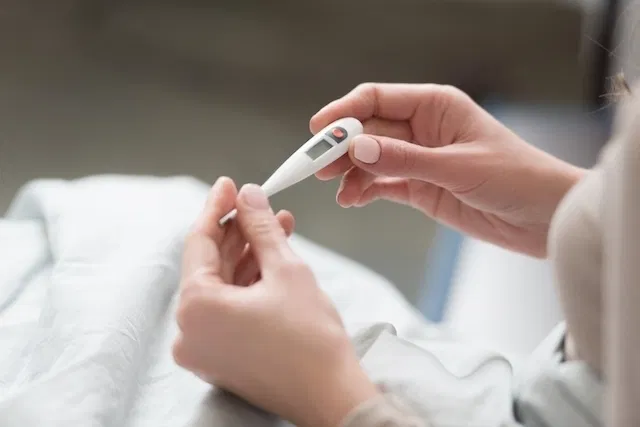Body temperatures above 100.4ºF (38ºC) are considered to be a fever. They usually occur as a response to infections (e.g. a UTI or tonsillitis) or inflammation (e.g. arthritis or lupus).
A low-grade fever, which is between 100.4 to 101.3ºF (or 38 to 38.5ºC), can be treated at home using natural remedies, like having warm bath or drinking white willow bark tea.
If the fever does not resolve with home remedies, however, or if the temperature continues to climb, you should see your doctor for assessment. The fever may require treatment with medication, such as acetaminophen.

Quick natural tips to lower a fever
There are several natural methods that can help to lower a fever before you need to use any type of home remedy or medication. These are:
- Removing excess clothing;
- Sitting near a fan or in a well-ventilated room;
- Placing a cold, wet towel on the forehead and wrists;
- Taking a bath with warm water. Make sure the temperature is not too hot or too cold;
- Drinking cold water;
- Eating an orange or tangerine, or drinking lemon juice to strengthen the immune system.
However, if the patient with a fever is under 3 months old, or has a history of cardiac or lung disease, or has dementia they must be seen by doctor as soon as possible, especially if the fever is over 100.4ºF (38ºC). The same applies to all older adults people, who may have more difficulty assessing their own temperature.
Medications that may be used
If a fever is very high and natural options are not sufficient to lower it, a doctor may advise the use of antipyretics, such as:
- Acetaminogen (e.g. Tylenol);
- Ibuprofen (e.g. Advil).
- Acetylsalicylic acid (e.g. Aspirin).
Ensure you only use these drugs if you have a high fever. If the fever persists and does not improve with medication, you should follow-up with your doctor to identify the cause of your fever. An infection, for example, may require antibiotic medication for treatment.
With children, dosing of medication will vary depending on weight, therefore it is important to confirm dosing with your doctor before starting any medication.

Best home remedies
Another good way to break a fever before resorting to medication is to have a warm tea that triggers sweating, which will help to lower body temperature. Please be aware that the following medicinal plants should not be given to babies without a doctor’s supervision:
1. Ash tree tea
Ash tree tea lowers a fever and also has anti-inflammatory and analgesic properties that relieve discomfort associated with fevers.
Ingredients
- 50g of ash tree bark;
- 1 liter (33 oz) of hot water.
Preparation method
Place the ash tree bark in water, let it boil for 10 minutes and then strain it the infusion. Drink three to four cups per day until the fever resolves.
2. Cinchona bark tea
Cinchona bark tea helps to lower a fever and it also contains antibacterial properties. It’s even more effective when taken together with white willow bark tea and meadowsweet tea.
Ingredients
- 0.5 g of finely chopped cinchona bark;
- 1 cup of water.
Preparation method
Place the cinchona bark tea in water and let it boil for 10 minutes. Drink 3 cups a day before meals.
3. White willow bark tea
White willow bark tea helps to lower a fever because this medicinal plant has glycosides in the bark which contain anti-inflammatory, analgesic, and antipyretic effects.
Ingredients
- 2 to 3 grams of white willow bark;
- 1 cup of water.
Preparation method
Place the white willow bark in water and let it boil for 10 minutes. Then strain the mixture and drink one cup before each meal.
There are other teas that you can take to lower a fever, such as achyrocline satureioides tea, holy thistle, or basil. Read more about how to measure your temperature and how to treat a fever.
What not to do when a child has a fever
Fever is a very common condition in children that can cause great anxiety in the family. However, it is important to avoid doing certain things that can make the situation worse:
- Trying to heat the child by putting more clothes or bed covers on them;
- Using drugs to lower fever at set times;
- Deciding to treat a fever with antibiotics you may have at home;
- Insisting the child eats normally and abundantly;
- Assuming the fever is high because of a new tooth erupting.
Sometimes, it is understandable for a child to have febrile convulsions because their brain is still immature, so the nervous system is more vulnerable to a quick rise in temperature. When this happens, it is important to note the start and finish times of the crisis, place the child on their side, and reduce the temperature in the atmosphere until the child wakes up. If it is the first febrile convulsion, proceed immediately to the emergency department.
Read more about how to treat fevers in babies and children.
When to seek medical attention
We recommend you visit the child’s pediatrician when the fever also occurs with the following symptoms:
- Vomiting;
- Intense headache;
- Irritability;
- Excessive tiredness;
- Difficulty breathing;
Children under 2 years old with a temperature over 40º should always be assessed by a pediatrician as there is a higher risk for complications.
